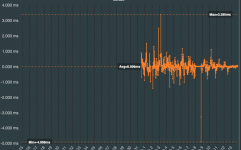# ATOMIC TIME.
# The Coordinated Universal Time (UTC) is the reference time scale derived
# from The "Temps Atomique International" (TAI) calculated by the Bureau
# International des Poids et Mesures (BIPM) using a worldwide network of atomic
# clocks. UTC differs from TAI by an integer number of seconds; it is the basis
# of all activities in the world.
#
#
# ASTRONOMICAL TIME (UT1) is the time scale based on the rate of rotation of the earth.
# It is now mainly derived from Very Long Baseline Interferometry (VLBI). The various
# irregular fluctuations progressively detected in the rotation rate of the Earth lead
# in 1972 to the replacement of UT1 by UTC as the reference time scale.
#
#
# LEAP SECOND
# Atomic clocks are more stable than the rate of the earth rotation since the latter
# undergoes a full range of geophysical perturbations at various time scales: lunisolar
# and core-mantle torques, atmospheric and oceanic effetcs, etc.
# Leap seconds are needed to keep the two time scales in agreement, i.e. UT1-UTC smaller
# than 0.9 second. Therefore, when necessary a "leap second" is applied to UTC.
# Since the adoption of this system in 1972 it has been necessary to add a number of seconds to UTC,
# firstly due to the initial choice of the value of the second (1/86400 mean solar day of
# the year 1820) and secondly to the general slowing down of the Earth's rotation. It is
# theorically possible to have a negative leap second (a second removed from UTC), but so far,
# all leap seconds have been positive (a second has been added to UTC). Based on what we know about
# the earth's rotation, it is unlikely that we will ever have a negative leap second.
#
#
# HISTORY
# The first leap second was added on June 30, 1972. Until yhe year 2000, it was necessary in average to add a
# leap second at a rate of 1 to 2 years. Since the year 2000 leap seconds are introduced with an
# average interval of 3 to 4 years due to the acceleration of the Earth rotation speed.
#
#
# RESPONSABILITY OF THE DECISION TO INTRODUCE A LEAP SECOND IN UTC
# The decision to introduce a leap second in UTC is the responsibility of the Earth Orientation Center of
# the International Earth Rotation and reference System Service (IERS). This center is located at Paris
# Observatory. According to international agreements, leap seconds should only be scheduled for certain dates:
# first preference is given to the end of December and June, and second preference at the end of March
# and September. Since the introduction of leap seconds in 1972, only dates in June and December were used.
#
# Questions or comments to:
# Christian Bizouard: christian.bizouard@obspm.fr
# Earth orientation Center of the IERS
# Paris Observatory, France
#
#
#
#
# VALIDITY OF THE FILE
# It is important to express the validity of the file. These next two dates are
# given in units of seconds since 1900.0.
#
# 1) Last update of the file.
#
# Updated through IERS Bulletin C (ftp://hpiers.obspm.fr/iers/bul/bulc/bulletinc.dat)
#
# The following line shows the last update of this file in NTP timestamp:
#
#$ 3819011916
#
# 2) Expiration date of the file given on a semi-annual basis: last June or last December
#
# File expires on 28 December 2021
#
# Expire date in NTP timestamp:
#
#@ 3849638400
#
#
# LIST OF LEAP SECONDS
# NTP timestamp (X parameter) is the number of seconds since 1900.0
#
# MJD: The Modified Julian Day number. MJD = X/86400 + 15020
#
# DTAI: The difference DTAI= TAI-UTC in units of seconds
# It is the quantity to add to UTC to get the time in TAI
#
# Day Month Year : epoch in clear
#
#NTP Time DTAI Day Month Year
#
2272060800 10 # 1 Jan 1972
2287785600 11 # 1 Jul 1972
2303683200 12 # 1 Jan 1973
2335219200 13 # 1 Jan 1974
2366755200 14 # 1 Jan 1975
2398291200 15 # 1 Jan 1976
2429913600 16 # 1 Jan 1977
2461449600 17 # 1 Jan 1978
2492985600 18 # 1 Jan 1979
2524521600 19 # 1 Jan 1980
2571782400 20 # 1 Jul 1981
2603318400 21 # 1 Jul 1982
2634854400 22 # 1 Jul 1983
2698012800 23 # 1 Jul 1985
2776982400 24 # 1 Jan 1988
2840140800 25 # 1 Jan 1990
2871676800 26 # 1 Jan 1991
2918937600 27 # 1 Jul 1992
2950473600 28 # 1 Jul 1993
2982009600 29 # 1 Jul 1994
3029443200 30 # 1 Jan 1996
3076704000 31 # 1 Jul 1997
3124137600 32 # 1 Jan 1999
3345062400 33 # 1 Jan 2006
3439756800 34 # 1 Jan 2009
3550089600 35 # 1 Jul 2012
3644697600 36 # 1 Jul 2015
3692217600 37 # 1 Jan 2017
#
# A hash code has been generated to be able to verify the integrity
# of this file. For more information about using this hash code,
# see the README file in the 'sources' directory.
#
#h 89073fa8 9e913fd7 60559aa5 29d1feee 5b0f6c91



